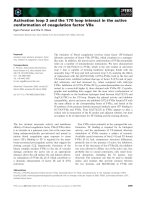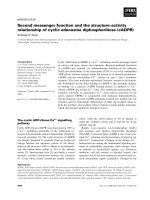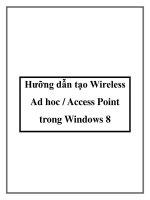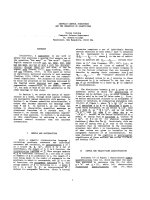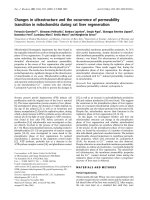wireless ad hoc networking personal-area, local-area, and the sensory-area networks
Bạn đang xem bản rút gọn của tài liệu. Xem và tải ngay bản đầy đủ của tài liệu tại đây (9.84 MB, 660 trang )
WIRELESS
AD HOC
NETWORKING
AUERBACH PUBLICATIONS
www.auerbach-publications.com
To Order Call: 1-800-272-7737 • Fax: 1-800-374-3401
E-mail:
Millimeter Wave Technology in Wireless PAN, LAN, and MAN
Shao-Qiu Xiao, Ming-Tuo Zhou and Yan Zhang
ISBN: 0-8493-8227-0
Security in Wireless Mesh Networks
Yan Zhang, Jun Zheng and Honglin Hu
ISBN: 0-8493-8250-5
Resource, Mobility and Security Management in Wireless Networks
and Mobile Communications
Yan Zhang, Honglin Hu, and Masayuki Fujise
ISBN: 0-8493-8036-7
Wireless Mesh Networking: Architectures, Protocols and Standards
Yan Zhang, Jijun Luo and Honglin Hu
ISBN: 0-8493-7399-9
Wireless Ad Hoc Networking: Personal-Area, Local-Area, and
the Sensory-Area Networks
Shih-Lin Wu and Yu-Chee Tseng
ISBN: 0-8493-9254-3
Wireless Metropolitan Area Networks: WiMAX and Beyond
Yan Zhang and Hsiao-Hwa Chen
ISBN: 0-8493-2624-9
Distributed Antenna Systems: Open Architecture for Future
Wireless Communications
Honglin Hu, Yan Zhang and Jijun Luo
ISBN:1-4200-4288-2
Series Editor: Yan Zhang
WIRELESS NETWORKS
AND MOBILE COMMUNICATIONS
Boca Raton New York
Auerbach Publications is an imprint of the
Taylor & Francis Group, an informa business
WIRELESS
AD HOC
NETWORKING
Personal-Area, Local-Area, and the Sensory-Area Networks
Edited by
Shih-Lin Wu Yu-Chee Tseng
Auerbach Publications
Taylor & Francis Group
6000 Broken Sound Parkway NW, Suite 300
Boca Raton, FL 33487‑2742
© 2007 by Taylor & Francis Group, LLC
Auerbach is an imprint of Taylor & Francis Group, an Informa business
No claim to original U.S. Government works
Printed in the United States of America on acid‑free paper
10 9 8 7 6 5 4 3 2 1
International Standard Book Number‑10: 0‑8493‑9254‑3 (Hardcover)
International Standard Book Number‑13: 978‑0‑8493‑9254‑2 (Hardcover)
This book contains information obtained from authentic and highly regarded sources. Reprinted
material is quoted with permission, and sources are indicated. A wide variety of references are
listed. Reasonable efforts have been made to publish reliable data and information, but the author
and the publisher cannot assume responsibility for the validity of all materials or for the conse‑
quences of their use.
No part of this book may be reprinted, reproduced, transmitted, or utilized in any form by any
electronic, mechanical, or other means, now known or hereafter invented, including photocopying,
microfilming, and recording, or in any information storage or retrieval system, without written
permission from the publishers.
For permission to photocopy or use material electronically from this work, please access www.
copyright.com ( or contact the Copyright Clearance Center, Inc. (CCC)
222 Rosewood Drive, Danvers, MA 01923, 978‑750‑8400. CCC is a not‑for‑profit organization that
provides licenses and registration for a variety of users. For organizations that have been granted a
photocopy license by the CCC, a separate system of payment has been arranged.
Trademark Notice: Product or corporate names may be trademarks or registered trademarks, and
are used only for identification and explanation without intent to infringe.
Library of Congress Cataloging‑in‑Publication Data
Wireless ad hoc networking : personal‑area, local‑area, and the sensory‑area
networks / editors, Shih‑Lin Wu and Yu‑Chee Tseng.
p. cm. ‑‑ (Wireless networks and mobile communications)
Includes bibliographical references and index.
ISBN‑13: 978‑0‑8493‑9254‑2 (alk. paper)
ISBN‑10: 0‑8493‑9254‑3 (alk. paper)
1. Wireless LANs. 2. Wireless communication systems. 3. Sensor networks.
I. Wu, Shih‑Lin. II. Tseng, Yu‑Chee. III. Title. IV. Series.
TK5105.78.W59 2007
004.6’8‑‑dc22 2006031857
Visit the Taylor & Francis Web site at
and the Auerbach Web site at
rbach‑publications.com
Contents
PART I: WIRELESS PERSONAL-AREA AND SENSORY-AREA
NETWORKS
1
Coverage and Connectivity of Wireless Sensor Networks 3
1.1 Introduction 3
1.2 Computing Coverage of a Wireless Sensor Network 4
1.3 Coverage and Scheduling 14
1.4 Coverage and Connectivity 20
1.5 Conclusions 23
2 Communication Protocols 25
2.1 Introduction 25
2.2 Similarities and Differences between WSNs and MANETs 28
2.3 Communication Patterns in Wireless Sensor Networks 30
2.4 Routing Protocols in WSNs 39
2.5 Comparative Studies 53
2.6 Conclusions and Future Research Directions 56
3 FireFly: A Time-Synchronized Real-Time Sensor
Networking Platform 65
3.1 Introduction 65
3.2 The FireFly Sensor Node 67
3.3 RT-Link: A TDMA Link Layer Protocol for Multihop
Wireless Networks 71
3.4 Nano-RK: A Resource-Centric RTOS for Sensor Networks 87
3.5 Coal Mine Safety Application 98
3.6 Summary and Concluding Remarks 102
4 Energy Conservation in Sensor and Sensor-Actuator
Networks 107
4.1 Introduction 107
4.2 Localized Algorithms Save Energy 110
v
vi
Contents
4.3 Minimum-Energy Broadcasting and Multicasting 113
4.4 Power-Aware Routing 115
4.5 Controlled Mobility for Power-Aware Localized Routing 116
4.6 Power-Efficient Neighbor Communication and Discovery
for Asymmetric Links 118
4.7 Challenges of Power-Aware Routing with a Realistic
Physical Layer 119
4.8 A Localized Coordination Framework for Wireless Sensor
and Actuator Networks 121
4.9 Localized Movement Control Algorithms for
Realization of Fault Tolerant Sensor and Sensor-
Actuator Networks 128
4.10 Conclusion 130
5 Security in Wireless Sensor Networks 135
5.1 Introduction 136
5.2 Physical Layer Security 136
5.3 Key Management 140
5.4 Link Layer Security 155
5.5 Network Layer Security 157
5.6 Application Layer Security 159
6 Autonomous Swarm-Bot Systems for Wireless
Sensor Networks 167
6.1 Introduction 167
6.2 The System Architecture 168
6.3 Cooperative Localization Algorithm 169
6.4 Foraging and Gathering 172
6.5 Minimap Integration 178
6.6 The Collaborative Path Planning Algorithm 181
6.7 Conclusion 184
7 A Smart Blind Alarm Surveillance and Blind
Guide Network System on Wireless Optical
Communication 191
7.1 Introduction 191
7.2 The Manufacture of Wireless Optical Transceiver 193
7.3 The Design of Wireless Optical Network 196
7.4 Smart Wireless Optical Blind-Guidance Cane and
Blind-Guidance Robot 199
7.5 The Design of a Smart Guide System with Wireless Optical
Blind-Guidance Cane and a Blind-Guidance Robot 203
7.6 Smart Wireless Optical Communication of Blind Alarm
Surveillance System 210
7.7 The Design and Implementation of a Smart Wireless
Blind-Guidance Alarm Surveillance System 214
Contents
vii
PART II: WIRELESS LOCAL-AREA NETWORKS
8
Opportunism in Wireless Networks: Principles and
Techniques 223
8.1 Opportunism: Avenues and Basic Principles 223
8.2 Source Opportunism 227
8.3 Spatio-Temporal Opportunism over a Single Link 234
8.4 Spatio-Temporal Opportunism in Ad Hoc Networks 241
8.5 Spatiotemporal-Spectral Opportunism in Ad Hoc Networks 247
8.6 Conclusions 250
9 Localization Techniques for Wireless Local Area
Networks 255
9.1 Introduction 255
9.2 Nondedicated Localization Techniques 256
9.3 Location Tracking 272
9.4 Conclusion 274
10 Channel Assignment in Wireless Local Area Networks 277
10.1 Introduction 277
10.2 Preliminaries 280
10.3 Rings 282
10.4 Grids 285
10.5 Interval Graphs 288
10.6 Trees 292
10.7 Conclusion 296
11 MultiChannel MAC Protocols for Mobile Ad Hoc
Networks 301
11.1 Introduction 301
11.2 Design Issues of Multichannel Protocols 302
11.3 Multichannel Protocols 303
11.4 Comparison of Multichannel MAC Protocols 320
11.5 Open Issues 321
11.6 Conclusions 322
12 Enhancing Quality of Service for Wireless Ad Hoc
Networks 325
12.1 Introduction 326
12.2 Background 327
12.3 The Proposed EDCF-DM Protocol 331
12.4 Performance Evaluation 334
12.5 Conclusions 340
13 QoS Routing Protocols for Mobile Ad Hoc Networks 343
13.1 Introduction 343
13.2 Reviews of the QoS Routing Protocols 345
13.3 Our QoS Routing Protocol 348
viii
Contents
13.4 Simulation Results 360
13.5 Conclusions 367
14 Energy Conservation Protocols for Wireless Ad Hoc
Networks 371
14.1 Introduction 371
14.2 Power Management 371
14.3 Power Control 382
14.4 Topology Control Protocols 387
14.5 Summary 397
15 Wireless LAN Security 399
15.1 WEP and Its Security Weaknesses 399
15.2 802.1X Security Measures 405
15.3 IEEE 802.11i Security 410
15.4 Summary 417
16 Temporal Key Integrity Protocol and Its Security
Issues in IEEE 802.11i 419
16.1 Introduction 419
16.2 Wired Equivalent Privacy and Its Weakness 420
16.3 Wi-Fi Protected Access 421
16.4 Temporal Key Integrity Protocol 423
16.5 Fragility of Michael 430
16.6 TKIP Countermeasures 431
16.7 Key Handshake Procedure 433
16.8 Conclusions 434
PART III: INTEGRATED SYSTEMS
17
Wireless Mesh Networks: Design Principles 439
17.1 Introduction 439
17.2 Generic Architecture and Basic Requirements of
Wireless Mesh Networks 439
17.3 Network-Planning Techniques 442
17.4 Self-Configuring Techniques 448
17.5 Conclusions 458
18 Wireless Mesh Networks: Multichannel Protocols
and Standard Activities 461
18.1 Introduction 461
18.2 Multichannel MAC Protocols 462
18.3 Multichannel Routing Protocols 473
18.4 Standard Activities of Mesh Networks 478
18.5 Conclusions 481
Contents
ix
19 Integrated Heterogeneous Wireless Networks 483
19.1 Introduction 483
19.2 Integration of Infrastructure-Based Heterogeneous
Wireless Networks 485
19.3 Heterogeneous Wireless Multihop Networks 492
19.4 Research Issues for Heterogeneous Wireless Networks 500
19.5 Conclusions 502
20 Intrusion Detection for Wireless Network 505
20.1 Introduction 505
20.2 Background on Intrusion Detection 505
20.3 Intrusion Detection for Mobile Ad Hoc Networks 506
20.4 Intrusion Detection for Wireless Sensor Networks 519
20.5 Conclusion 530
21 Security Issues in an Integrated Cellular
Network—WLAN and MANET 535
21.1 Introduction 535
21.2 Architecture of the Integrated Network 537
21.3 Security Impacts from the Unique Network Characteristics 540
21.4 Potential Security Threats 542
21.5 An Investigation and Analysis of Security Protocols 554
21.6 New Security Issues and Challenges 564
21.7 Conclusion 566
22 Fieldbus for Distributed Control Applications 571
22.1 Introduction 571
22.2 Review on Distributed Control 577
22.3 Fundamental Aspects of DCS 578
22.4 Standards, Frequency Bands, and Issues 580
22.5 Some of the Major Wireless Fieldbuses 583
22.6 Selecting a Fieldbus 590
22.7 Discussion and Conclusions 591
23 Supporting Multimedia Communication in the
Integrated WCDMA/WLAN/Ad Hoc Networks 595
23.1 Introduction 595
23.2 Multiple Accesses in CDMA Uplink 599
23.3 Multiple Accesses in CDMA Downlink 605
23.4 Mobility Management 613
23.5 Design Integration with Ad Hoc Networks 620
Index 629
Preface
The rapid progress of mobile/wireless communication and embedded
microsensing MEMS technologies leads us toward the dream “Ubiqui-
tous/Pervasive Computing.” Wireless local-area networks (WLANs) have
been widely deployed in many cities and have become a requisite tool to
many people in their daily lives. Wireless personal-area networks (WPANs)
provide a cableless personal working area by using wireless interconnec-
tion among devices, such as personal computer, printer, personal digital
assistant, and digital camera. A wireless sensor node is an integrated device
which consists chiefly of a sensor part, a wireless communication part, and
an information processing unit. Wireless sensor nodes can be deployed
in a sensing field to monitor events that we are interested in. In par-
ticular, the human body could be a potential sensing field. By backing
events in the body area, wearable sensor networks may greatly improve
our daily life. By integrating these multidiscipline technologies into a per-
vasive system, we can access information and acquire computing resources
anytime, anywhere with any device. The pervasive system can be used in
a wide range of applications such as home automation, health care, trans-
portation, agriculture, scientific survey, industrial automation, and military
applications.
This book aims to provide a wide coverage of key technologies in wire-
less ad hoc networks including networking architectures and protocols,
cross-layer architectures, localization and location tracking, power man-
agement and energy-efficient design, power and topology control, time
synchronization, coverage issues, middleware and software design, data
gathering and processing, embedded network-oriented operating systems,
mobility management, self-organization and governance, QoS and real-time
issues, security and dependability issues, integrated wired/wireless/sensor
networks and systems, applications, modeling and performance evaluation,
xi
xii
Preface
implementation experience, and measurements. We believe that there is no
other existing book that brings the concept—ad hoc networking—together
with its key technologies and applications over the platforms—personal-
area, sensory-area, and local-area networks—in a single work. The book
contains three parts and each part has several self-contained chapters
written by experts and researchers from around the world.
The potential audience for this book includes researchers and students
who want to specialize in the field of computer science and electrical engi-
neering, professionals and engineers who are designers or planners for
wireless sensory-, personal-, and local-area networks, and those who are
interested in the ubiquitous/pervasive environment.
This book is a collective work of many excellent experts and researchers.
We would like to express our immense gratitude to these authors for
their valuable contributions. It has been a pleasure to work with Richard
O’Hanley of Auerbach Publications (Taylor & Francis Group) for their pro-
fessional support and encouragement to publish this book. We would also
like to thank Catherine Giacari of CRC Press (editorial project development)
for her kindly help in this project. Finally, we appreciate our family for their
great patience and enormous love throughout the publishing work.
The Authors
Shih-Lin Wu received his BS degree in
Computer Science from Tamkang Univer-
sity, Taiwan, in June 1987 and his PhD
degree in Computer Science and Information
Engineering from National Central Univer-
sity, Taiwan, in May 2001. From August 2001
to July 2003, he was an Assistant Professor
in the faculty of the Department of Electrical
Engineering, Chang Gung University, Tai-
wan. Since August 2003, he has been with
the Department of Computer Science and
Information Engineering, Chang Gung Uni-
versity. Dr. Wu served as a Program Chair in
the Mobile Computing Workshop, 2005 and as a guest editor for the spe-
cial issue of Journal of Pervasive Computing and Communication on “Key
Technologies and Applications of Wireless Sensor and Ad Hoc Networks.”
Several of his papers have been chosen as best papers in international con-
ferences. His current research interests include mobile computing, wireless
networks, distributed robotics, and network security. Dr. Wu is a member
of the IEEE and the Phi Tau Phi Society.
xiii
xiv
The Authors
Yu-Chee Tseng received his BS and MS
degrees in Computer Science from the
National Taiwan University and the National
Tsing-Hua University in 1985 and 1987,
respectively. He obtained his PhD in Com-
puter and Information Science from the Ohio
State University in January 1994. He was an
associate professor at the Chung-Hua Univer-
sity (1994–1996) and at the National Central
University (1996–1999), and a professor at
the National Central University (1999–2000).
Since 2000, he has been a professor in the
Department of Computer Science, National
Chiao-Tung University, Taiwan, where he is currently its chairman.
Dr. Tseng served as a Program Chair in the Wireless Networks and Mobile
Computing Workshop, 2000 and 2001, as a Vice-Program Chair in the Inter-
national Conference on Distributed Computing Systems (ICDCS), 2004, as
well as of the IEEE International Conference on Mobile Ad-hoc and Sensor
Systems (MASS), 2004, as an associate editor for The Computer Journal,as
a guest editor for the special issue of ACM Wireless Networks on “Advances
in Mobile and Wireless Systems,” as a guest editor for the special issue
of IEEE Transactions on Computers on “Wireless Internet,” as a guest edi-
tor for the special issue of Journal of Internet Technology on “Wireless
Internet: Applications and Systems,” as a guest editor for the special issue
of Wireless Communications and Mobile Computing on “Research in
Ad Hoc Networking, Smart Sensing, and Pervasive Computing,” as an editor
for Journal of Information Science and Engineering, as a guest editor for
the special issue of Telecommunication Systems on “Wireless Sensor Net-
works,” and as a guest editor for the special issue of Journal of Information
Science and Engineering on “Mobile Computing.”
Dr. Tseng received the Outstanding Research Award from the National
Science Council, ROC, in both 2001–2002 and 2003–2005, the Best Paper
Award at the International Conference on Parallel Processing in 2003, the
Elite I. T. Award in 2004, and the Distinguished Alumnus Award from the
Ohio State University in 2005. His research interests include mobile comput-
ing, wireless communication, network security, and parallel and distributed
computing. Dr. Tseng is a member of ACM and a Senior Member of IEEE.
Contributors
Dharma P. Agrawal
OBR Center for Distributed and
Mobile Computing
Department of ECECS
University of Cincinnati
Cincinnati, Ohio
Alan A. Bertossi
Department of Computer Science
University of Bologna
Bologna, Italy
Guohong Cao
Department of Computer Science and
Engineering
The Pennsylvania State University
University Park, Pennsylvania
Dave Cavalcanti
Wireless Communications and
Networking Department
Philips Research North America
Briarcliff Manor, New York
Chao-Hsin Chang
Department of Computer Science and
Information Engineering
Chang Gung University
Taoyuan, Taiwan
Chih-Yung Chang
Department of Computer Science and
Information Engineering
Tamkang University
Tamsui, Taiwan
Jenhui Chen
Department of Computer Science and
Information Engineering
Chang Gung University
Taoyuan, Taiwan
Shu-Min Chen
Department of Computer Science
National Chiao Tung University
Hsinchu, Taiwan
Jen-Shiun Chiang
Department of Electrical Engineering
Tamkang University
Tamsui, Taiwan
Yung-Shan Chou
Department of Electrical Engineering
Tamkang University
Tamsui, Taiwan
Po-Jen Chuang
Department of Electrical Engineering
Tamkang University
Tamsui, Taiwan
xv
xvi
Contributors
Kamal Dass
Department of Computer Science
The University of Alabama
Tuscaloosa, Alabama
Cheng-Chang Ho
Department of Electrical Engineering
Tamkang University
Tamsui, Taiwan
Chih-Shun Hsu
Department of Computer Science and
Information Engineering
Nanya Institute of Technology
Jhongli, Taiwan
Rong-Hong Jan
Department of Computer Science
National Chiao Tung University
Hsinchu, Taiwan
Yih-Guang Jan
Department of Electrical Engineering
Tamkang University
Tamsui, Taiwan
Huan-Chao Keh
Department of Computer Science and
Information Engineering
Tamkang University
Tamsui, Taiwan
Cynthia Kersey
Department of Computer Science
University of Illinois
Chicago, Illinois
Ahmad Khoshnevis
Department of Electrical and Computer
Engineering
Rice University
Houston, Texas
Kiseon Kim
Gwangju Institute of Science
and Technology
Gwangju, South Korea
Anup Kumar
Department of Computer Engineering
and Computer Science
University of Louisville
Louisville, Kentucky
Hsiao-Ju Kuo
Department of Computer Science
National Chiao Tung University
Hsinchu, Taiwan
Sheng-Po Kuo
Department of Computer Science
National Chiao Tung University
Hsinchu, Taiwan
Yang-Han Lee
Department of Electrical Engineering
Tamkang University
Tamsui, Taiwan
Chih-Yu Lin
Department of Computer Science
National Chiao Tung University
Hsinchu, Taiwan
Jheng-Yao Lin
Department of Electrical Engineering
Tamkang University
Tamsui, Taiwan
Jonathan C.L. Liu
Computer, Information Science
and Engineering
University of Florida
Gainesville, Florida
Yunhuai Liu
Department of Computer Science
Hong Kong University of Science and
Technology
Hong Kong, China
N.P. Mahalik
Gwangju Institute of Science and
Technology
Gwangju, South Korea
Contributors
xvii
Rahul Mangharam
Department of Electrical and Computer
Engineering
Carnegie Mellon University
Pittsburgh, Pennsylvania
Lionel M. Ni
Computer Science Department
Hong Kong University of Science and
Technology
Hong Kong, China
M. Cristina Pinotti
Department of Computer Science and
Mathematics
University of Perugia
Perugia, Italy
Anthony Rowe
Department of Electrical and Computer
Engineering
Carnegie Mellon University
Pittsburgh, Pennsylvania
Raj Rajkumar
Department of Electrical and Computer
Engineering
Carnegie Mellon University
Pittsburgh, Pennsylvania
Ashutosh Sabharwal
Department of Electrical and Computer
Engineering
Rice University
Houston, Texas
Loren Schwiebert
Department of Computer Science
Wayne State University
Detroit, Michigan
Jang-Ping Sheu
Department of Computer Science and
Information Engineering
National Central University
Jhongli, Taiwan
Shiann-Tsong Sheu
Department of Communication
Engineering
National Central University
Jhongli, Taiwan
Kuei-Ping Shih
Department of Computer Science and
Information Engineering
Tamkang University
Tamsui, Taiwan
Ivan Stojmenovic
SITE
University of Ottawa
Ontario, Canada
Wai-Hong Tam
Department of Computer Science
National Chiao Tung University
Hsinchu, Taiwan
Jeffrey J.P. Tsai
Department of Computer Science
University of Illinois
Chicago, Illinois
Hsien-Wei Tseng
Department of Electrical Engineering
Tamkang University
Tamsui, Taiwan
Huei-Ru Tseng
Department of Computer Science
National Chiao Tung University
Hsinchu, Taiwan
Yu-Chee Tseng
Department of Computer Science
National Chiao Tung University
Hsinchu, Taiwan
Shen-Chien Tung
Department of Computer Science and
Information Engineering
National Central University
Jhongli, Taiwan
xviii
Contributors
Ju Wang
Department of Computer Science
Virginia Commonwealth University
Richmond, Virginia
Ching-Chang Wong
Department of Electrical
Engineering
Tamkang University
Tamsui, Taiwan
Fang-Jing Wu
Department of Computer Science
National Chiao Tung University
Hsinchu, Taiwan
Kui Wu
Department of Computer Science
University of Victoria
Victoria, Canada
Rung-Hou Wu
Department of Computer Science and
Communication Engineering
St. John’s University
Tamsui, Taiwan
Shih-Lin Wu
Department of Computer Science and
Information Engineering
Chang Gung University
Taoyuan, Taiwan
Yong Xi
Department of Computer Science
Wayne State University
Detroit, Michigan
Yang Xiao
Department of Computer Science
The University of Alabama
Tuscaloosa, Alabama
Bin Xie
Department of Computer Engineering
and Computer Science
University of Louisville
Louisville, Kentucky
Jhen-Yu Yang
Department of Computer Science and
Information Engineering
Chang Gung University
Taoyuan, Taiwan
Wuu Yang
Department of Computer Science
National Chiao Tung University
Hsinchu, Taiwan
Zhenwei Yu
Department of Computer Science
University of Illinois
Chicago, Illinois
Hao Zhu
Department of Electrical and
Computer Engineering
Florida International University
Miami, Florida
Jun Zheng
School of Information Technology
and Engineering
University of Ottawa
Ontario, Canada
I
WIRELESS
PERSONAL-AREA
AND SENSORY-AREA
NETWORKS
Chapter 1
Coverage and
Connectivity of Wireless
Sensor Networks
Hsiao-Ju Kuo, Sheng-Po Kuo, Fang-Jing Wu, and
Yu-Chee Tseng
1.1 Introduction
In a wireless sensor network, one central issue is to evaluate how well
the sensing field is monitored by sensors, also known as the coverage of
the network. The coverage issue is directly related to the sensing capabil-
ity of the network on monitoring phenomenons occurring in the sensing
area, such as intruders in a battlefield or fire events in a forest. After the
coverage is guaranteed, another important issue is to prolong the network
lifetime when sensors are more than necessary. More specifically, if sen-
sors are more than the required number, some of them can be scheduled to
turn off their power. These powered-off sensors can be activated later when
some powered-on sensors run out of energy. The scheduling should always
guarantee the required level of coverage. Furthermore, ensuring commu-
nication connectivity is also essential when scheduling sensors’ on-duty
time. Connectivity normally means that there is at least one path connect-
ing any two on-duty sensors and the gateway. This chapter is dedicated
to reviewing the related coverage- and connectivity-maintaining protocols
and algorithms.
3
4
Wireless Ad Hoc Networking
The organization of this chapter is as follows. Section 1.2 discusses
how to compute the coverage of a wireless sensor network. Section 1.3
introduces scheduling protocols that can put some sensors into the sleep
mode while maintaining the required level of coverage. Finally, some
mechanisms for maintaining both sensing coverage and communication
connectivity are presented in Section 1.4.
1.2 Computing Coverage of a Wireless Sensor
Network
Coverage is an essential problem in wireless sensor networks. It is impor-
tant to ensure that sensors provide sufficient coverage of the sensing field.
However, one should use as few sensors as possible to cover the sens-
ing field to reduce the hardware cost. Assuming that sensors are randomly
deployed, this section discusses three general models to define the cov-
erage problem and reviews some solutions to the coverage problem. The
first one is the binary model, where each sensor’s coverage area is mod-
eled by a disk. Any location within the disk is well monitored by the
sensor located at the center of the disk; otherwise, it is not monitored
by the sensor. The second one is the probabilistic model. An event hap-
pening in the coverage of a sensor is either detected or not detected by the
sensor depending on a probability distribution. Hence, even if an event
is very close to a sensor, it may still be missed by the sensor. The last
model considers the coverage problem by including the issue of how tar-
gets travel along the sensing field. The worst and best traveling paths of
this model can be used to evaluate the sensing capability of the sensor
network.
1.2.1 Coverage Solutions Based on the Binary Model
Under the binary model, the sensing range of a sensor is modeled by a
disk. The radii of disks representing sensors’ sensing ranges may be the
same or different. When an event occurs within a sensor’s sensing range, it
is well monitored by the sensor (i.e., all locations within the sensing range
of a sensor are under the same quality of surveillance). On the contrary,
locations outside the sensing region of a sensor are considered undetectable
by the sensor.
In Ref. [1], the coverage problem is defined as follows: we are given a
set of sensors, S ={s
1
, s
2
, , s
n
}, in a two-dimensional (2D) area A. Each
sensor s
i
, i =1, , n, is located at a coordinate (x
i
, y
i
) inside A and has a
sensing range of r
i
, i.e., it can monitor any point that is within a distance
of r
i
from s
i
.
Coverage and Connectivity of Wireless Sensor Networks
5
Definition 1
A location in A is said to be covered by s
i
if it is within s
i
’s sensing
range. A location in A is said to be j-covered if it is within at least
j sensors’ sensing ranges.
Definition 2
A subregion in A is a set of points that are covered by exactly
the same set of sensors.
Two versions of the coverage problem are defined as follows:
Definition 3
Given a natural number k, the k-non-unit-disk coverage (k-NC)
problem is to determine whether all points in A are k-covered
or not.
Definition 4
Given a natural number k, the k-unit-disk coverage (k-UC) prob-
lem is to determine whether all points in A are k-covered or not,
subject to the constraint that r
1
=r
2
=···=r
n
.
There are several reasons for asking a wireless sensor network to be
k-covered such that k > 1. First, it could be for the fault-tolerant reason.
Second, some special applications, such as trilateration, may require each
point in the sensing field to be at least 3-covered. Figure 1.1 illustrates how
sub regions of a sensing field are covered.
The work
2
proposes a solution to the k-UC. To determine the coverage
level, this work looks at how intersection points between sensors’ sensing
ranges are covered. It claims that a sensing field A is k-covered if all inter-
section points between each pair of sensors and between each sensor and
the boundary of this field A are at least k-covered. Based on this property,
a coverage configuration protocol (CCP) that can schedule sensors’ on-
duty time so as to maintain a given coverage level is presented in Ref. [2].
Initially, all sensors are in the active state. If some area are overly cov-
ered, redundant nodes may find themselves unnecessary and switch to the
sleep state. More specifically, a sensor need not stay active if all intersection
points within its sensing range are at least k-covered by other nodes in its
neighborhood excluding itself. A sleeping node also periodically wakes up
6
Wireless Ad Hoc Networking
1
1
1
1
1
2
2
1
1
2
3
2
3
4
3
3
3
1
2
2
3
2
2
3
2
2
1
2
2
2
3
2
1
2
3
2
1
2
2
2
2
2
3
3
2
3
2
2
2
2
2
2
2
2
2
2
2
2
2
1
1
1
1
1
1
1
3
3
3
3
3
3
3
3
3
2
(a)
(b)
2
2
2
3
2
2
2
2
2
3
2
2
3
4
4
4
4
3
3
3
3
3
3
2
3
4
3
3
4
5
4
3
4
3
2
5
4
3
3
3
3
3
5
5
5
4
4
4
5
5
5
6
4
6
4
5
5
4
4
4
2
3
2
4
3
3
3
3
4
4
3
4
2
3
4
5
3
4
4
5
3
4
3
3
3
4
3
3
4
5
2
2
4
2
3
3
4
3
4
4
3
3
4 4
4
2
3
4
4
3
4
4
5
6
4
4
4
2
3
3
5
2
3
3
4
5
5
6
4
4
5
3
4
5
3
5
3
4
4
3
2
5
4
4
3
3
Figure 1.1 Examples of the coverage problem: (a) the sensing field
is 1-covered by unit disks and (b) the sensing field is 2-covered
by nonunit disks. The number in each subregion is its cove
rage level.


